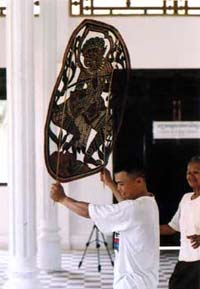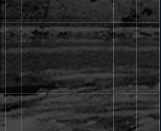
Photo
Copyright @ Valerie Ann Oliveiro |
Such
revival is manifest in the work of the traditional puppeteer, ,
Mann Kosal, who practices the art of nang shek. Cambodian
puppets are not like the smaller, articulated images familiar to
us from Java or Bali. They are 4 1/2 foot panels in which individuals
seem to bring their scenery with them. Until now, they have only
represented characters from the Ramayana but Mann has created Khmer
Rouge soldiers and other contemporary figures. A video highlight
shows him choosing a cowhide, curing the leathers and carving out
one of his creations. It will take its place along side those from
the ancient epic.
Continuum demands an approach that sets it apart from even
the most experimental artistic production. Its aesthetic comes from
trying to be involved with the people rather than with the form.
Keng Sen considers the process his group of artists are still discovering
one of healing, but also one of myth making, which brings us back,
not only to the new traditional puppets and the personal stories
that are classical dances, but also to that shrine to Pol Pot. Part
of the company’s original exploration involved actually trying
to summon up the monster. Keep in mind that the giant roles belonged
to Em Theay, and her daughter, as well as to Kim Bun Thom: "I
asked them as an experiment to wear the mask of the monster as Pol
Pot--to be Pol Pot. They actually wrote speeches as Pol Pot. That’s
not in the performance, but I felt it was an important stage in
the process. I would like to come back to that, because I feel that
one of the final stages of coming to terms with that time is to
put themselves into the antagonist’s place. I also had the
idea of a three-year process in a Cambodian university, working
with a writer to translate Em Theay’s story as a traditional
opera and in that way retrieve that form as well."
|
|


